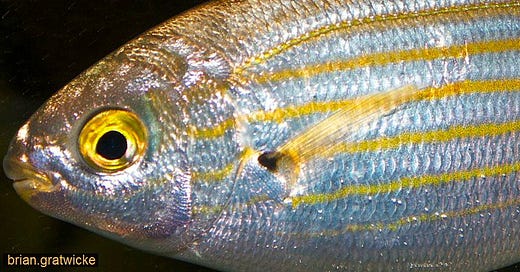I was pondering what to write about this week, when out of nowhere, psychedelic fish came to mind. I had a vague memory of reading about psychedelic fish years ago. Sure enough, after a quick search, I realized I wasn’t trippin. The sarpa salpa is a type of sea bream, and contains a psychedelic compound that has been making people hallucinate for millennia. Did the ancients use sarpa salpa for psychedelic rituals?
What is Sarpa Salpa?
Known by its common name, salema porgy, or its scientific name sarpa salpa, this fish is a common type of sea bream. The shimmering baby blue fish with notable yellow stripes, makes for easy identification.
The salema porgy’s habitat includes almost all of the Mediterranean, extends to Africa’s east coast, parts of the Atlantic and even to some areas of Polynesia. The salema porgy is a good eating fish and is considered a delicacy around the Mediterranean, landing on many restaurant menus.
The sarpa salpa is also known as the “dreamfish,” thanks to the Arabic denotation “the fish that makes dreams.” Why? The sea bream is psychedelic and can cause people to have hallucinations for days.
The Mysterious Psychedelic Effects of Sarpa Salpa
The dreamfish’s psychedelic qualities stem from ichthyoallyeinotoxism, a rare type of poisoning following fish consumption. The poisoning provokes a nervous system imbalance that incurs LSD-like visions and hallucinations that can last for days.
We don’t know the exact substance in the dreamfish responsible for the trip. Sarpa salpa may contain something akin to LSD or even DMT:
It’s not clear, though, which toxins are responsible for such a vivid response in the eater. They could be alkaloids of the indole group, compounds occurring naturally in certain algae and phytoplankton the fish eat and which are chemically similar in structure to LSD. Or a hallucinogen called dimethlytrypthamine (DMT), the same compound found in the spiritual healing brew ayahuasca, might be responsible.
When researching this article, I recalled who taught me about the dreamfish. I first read about it in Clifford Pickover’s 2005 book, Sex, Drugs, Einstein & Elves: Sushi, Psychedelics, Parallel Universes, and the Quest for Transcendence. In Sex, Drugs, Einstein & Elves’ first chapter Pickover details the fishy story around Norfolk Island, north of New Zealand:
Even more interesting than the psychedelic worms are the “dream fish” of Norfolk Island. Eat the dream fish—certain species of Kyphosus (Kyphosus fuscus or Kyphosus vaigiensis)—and you will have strange, exquisite dreams. German anthropologist Christian Ratsch, an authority on natural psychedelics, has suggested that the dream fish contain large amounts of the hallucinogen DMT or a related molecule. Whatever the precise molecule, the CIA once feared that the Russians would make use of the dream fish for developing dangerous nerve agents.
Besides MK-Ultra’s haunting echoes, Pickover also shares this trip report:
A few reporters have eaten the dream fish and described their strange effects. The most famous user is Joe Roberts, a photographer for the National Geographic magazine. He broiled the dream fish in 1960. After eating the delicacy, he experienced intense hallucinations with a science fiction theme that included futuristic vehicles, images of space exploration, and monuments marking humanity’s first trips into space.
But this may not be the most (in)famous case of dreamfish poisoning. This distinction belongs to an unfortunate tourist in France in 1994.
The dreamfish victim “...suffered from blurred vision, nausea and muscle weakness after eating this fish in a restaurant. Torturous hallucinations followed and he ended up in the hospital for three full days in quite a bad state.” This sarpa salpa trip report details the same story and its “...visions of giant screaming arthropods around the car of a disoriented forty-year-old executive on vacation in Cannes (April 1994).”
In a weird twist on this, let’s set aside human intoxication for a moment, and think about the animals, dolphins to be exact.
Do Dolphins Trip on Dreamfish?
As we know, dolphins are highly intelligent creatures and who knows, maybe they’re conscious too. Dolphins play with pufferfish and get high on them for example. This begets the question if dolphins eat dreamfish to take a trip.
For starters, we do know dolphins eat dreamfish. This dolphin study states “strepie (Sarpa salpa), have been noted to be important prey for common dolphins.” Here’s video proof of how much dolphins love eating dreamfish.
Why do dolphins love eating dreamfish so much? Are they getting high?
We still don’t know if dolphins are enjoying psychedelic experiences. Various factors influence whether dreamfish poisoning occurs or not in humans, and dolphins may complicate the phenomenon more. If this all sounds a little too crazy, don’t forget that John Lilly dosed dolphins with LSD to try to talk with them.
Maybe in reality, the dolphins dosed Lilly with LSD. Maybe the dolphins are dosing us too by way of dreamfish. In fact, ancient history tells us humans have been tripping on dreamfish for millennia.
Dreamfish in Ancient Gastronomy
A popular theory circulates on the internet positing that the ancient Romans ate dreamfish. I’m not sure if there’s any proof for this theory. Regardless, I’m pretty damn sure the Romans knew almost every type of Mediterranean fish, and likely poisoned themselves a few times by accident. Not long after, they were probably carrying bags full of dreamfish to gladiatorial games. Of course the Arabs had a word for the fish, so many people knew about its effects.
But who else knew about sarpa salpa? I think of the Eleusinian Mysteries and the kykeon. We still haven’t figured out what was in that. For now the best guess is ergot. But why not dreamfish? I’ve never heard dreamfish being a possibility in ancient psychedelic beverages.
We’re beginning to learn more about the ingredients in ancient psychedelic beverages. Brian Muraresku discusses this in his book The Immortality Key. That book introduced me to archeo chemistry and how technologies like mass spectrometry can analyze residue found on pottery shards and fragments to determine what was held inside. One day we may have proof of what ancient vessels held, and the secrets of their psychedelic brews.
Muraresku investigates many archaeological sites around the Mediterranean, including Italy, Spain, and Turkey. All of these areas have access to dreamfish.
Questions Surrounding Our Ancient Past
I’m a big fan of ancient civilizations, and in particular, non-mainstream ideas and new discoveries that have arisen in recent years. Göbekli Tepe comes to mind, located in eastern Turkey. Göbekli Tepe ties into Muraresku’s work:
From the Fertile Crescent to ancient Greece, mystical experiences appear to have been the driving force behind our transition from a hunter-gatherer existence to a settled, agrarian lifestyle rooted in the veneration of the ancestors. A tradition that ultimately produced Göbekli Tepe, the earliest temple, and its skull-worshipping death cult.
I’m not sure about the “skull-worshipping death cult” bit, but is there something here? Göbekli Tepe isn’t far from the Mediterranean. What or who could link Göbekli Tepe to ancient Rome? Could it be Mesopotamia and the Babylonians?
The Babylonian empire reached the eastern Mediterranean. So the Babylonians may have known about dreamfish. Have you ever heard of Oannes?
in Mesopotamian mythology, an amphibious being who taught mankind wisdom. Oannes, as described by the Babylonian priest Berosus, had the form of a fish but with the head of a man under his fish's head and under his fish's tail the feet of a man
Oannes is a “fish-man sage” who appears “...from the ocean every day to share his wisdom with people…” Oh and he carries a purse or a man-bag.
No one knows what the bag held. Everyone is always theorizing. The bag’s contents are believed to be quite important. It seems too obvious, right? Was Oannes carrying dreamfish?
Sarpa Salpa Sanctum?
Do we need a sarpa salpa sanctum? I just love the way it sounds, and I could probably design some cool t-shirts that have a sweet occult, esoteric vibe. All culty kidding aside, do we need dreamfish?
While smoking dried, psychedelic toad mucus gets all the attention, hype and cultural cachet, why has the dreamfish gotten zero? Why are there no studies being conducted on dreamfish? Where are the peer reviewed journal articles? Where are the investors? Where are the trials?
I don’t know. Are dreamfish studies worth it? Maybe. I know bufo and peyote both have sustainability and conservation issues. Is catching a few sea bream and farming them easier and better for the environment? It is 2025 and stranger things have already happened.
Maybe the answer to our future lies in the ancient past. Brian Muraresku talks about life’s greatest mystery, and the answer. He says the ancients used psychedelic rituals to “die before you die.” If dreamfish was involved, is this the catch and release our souls seek?





